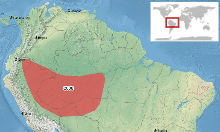Syncope bassleri
| Syncope bassleri | |
|---|---|
| Scientific classification | |
| Kingdom: | Animalia |
| Phylum: | Chordata |
| Class: | Amphibia |
| Order: | Anura |
| Family: | Microhylidae |
| Genus: | Syncope |
| Species: | S. bassleri |
| Binomial name | |
| Syncope bassleri (Dunn, 1949) | |
 | |
| Synonyms | |
|
Chiasmocleis bassleri Dunn, 1949 | |
Syncope bassleri (common name: Bassler's humming frog) is a species of frog in the Microhylidae family. It is found in Amazonian Brazil, Colombia, Ecuador, and Peru, and possibly in Bolivia.[2]
Description
Syncope bassleri are relatively small frogs: males measure about 15–20 mm (0.59–0.79 in) and females about 21–26 mm (0.83–1.02 in) in snout–vent length. Male frogs can be heard calling from under wet leaf litter, near pond edges.[3] The call consists of many sporadically emitted, short multi-pulsed notes (3–6 pulses).[4]
Habitat
Syncope bassleri is an abundant and widespread species in suitable habitats. It is found in terra firma primary and secondary tropical rainforest and in seasonally flooded forest.[1] They usually occur near isolated pools, hiding under leaves or pieces of bark.[3]
Syncope bassleri is adversely impacted by habitat loss due to forest clearing.[1]
References
- 1 2 3 Monteza, J.I., Azevedo-Ramos, C., Coloma, L.A. & Ron, S. (2004). "Chiasmocleis bassleri". IUCN Red List of Threatened Species. Version 2013.2. International Union for Conservation of Nature. Retrieved 1 March 2014.
- ↑ Frost, Darrel R. (2014). "Syncope bassleri (Dunn, 1949)". Amphibian Species of the World: an Online Reference. Version 6.0. American Museum of Natural History. Retrieved 1 March 2014.
- 1 2 Rodrigues, D.J.; J.C. Noronha; M.M. Lima; A.C. Rosa (2011). "Amphibia, Anura, Microhylidae, Chiasmocleis avilapiresae Peloso and Sturaro, 2008 and Chiasmocleis bassleri Dunn, 1949: New Distribution records". Check List 7 (6): 846–848.
- ↑ Santana, D. J.; Sant'Anna, A. C.; São-Pedro, V. A.; Feio, R. N. (2009). "The advertisement call of Chiasmocleis bassleri (Anura, Microhylidae) from southern Amazon, Mato Grosso, Brazil". South American Journal of Herpetology 4 (3): 225–228. doi:10.2994/057.004.0304.
